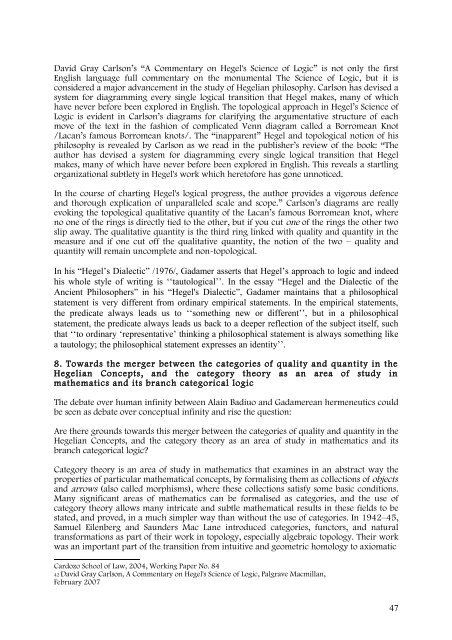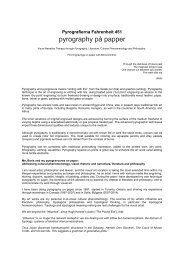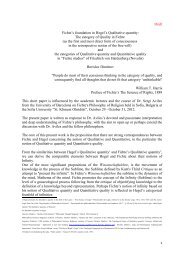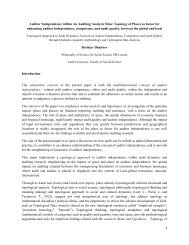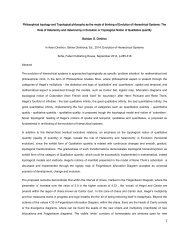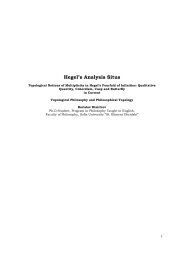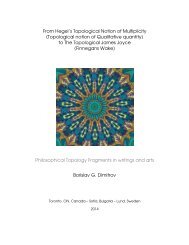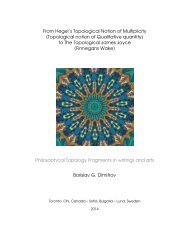Topological Ontology and Logic of Qualitative quantity
Qualitative quantity and BFO (Basic Formal Ontology) of /Barry Smith/ and YAMATO (Yet Another More Advanced Top-level Ontology) of /Riichiro Mizoguchi/
Qualitative quantity and BFO (Basic Formal Ontology) of /Barry Smith/ and YAMATO (Yet Another More Advanced Top-level Ontology) of /Riichiro Mizoguchi/
- No tags were found...
You also want an ePaper? Increase the reach of your titles
YUMPU automatically turns print PDFs into web optimized ePapers that Google loves.
David Gray Carlson’s “A Commentary on Hegel's Science <strong>of</strong> <strong>Logic</strong>” is not only the first<br />
English language full commentary on the monumental The Science <strong>of</strong> <strong>Logic</strong>, but it is<br />
considered a major advancement in the study <strong>of</strong> Hegelian philosophy. Carlson has devised a<br />
system for diagramming every single logical transition that Hegel makes, many <strong>of</strong> which<br />
have never before been explored in English. The topological approach in Hegel’s Science <strong>of</strong><br />
<strong>Logic</strong> is evident in Carlson’s diagrams for clarifying the argumentative structure <strong>of</strong> each<br />
move <strong>of</strong> the text in the fashion <strong>of</strong> complicated Venn diagram called a Borromean Knot<br />
/Lacan’s famous Borromean knots/. The “inapparent” Hegel <strong>and</strong> topological notion <strong>of</strong> his<br />
philosophy is revealed by Carlson as we read in the publisher’s review <strong>of</strong> the book: “The<br />
author has devised a system for diagramming every single logical transition that Hegel<br />
makes, many <strong>of</strong> which have never before been explored in English. This reveals a startling<br />
organizational subtlety in Hegel's work which heret<strong>of</strong>ore has gone unnoticed.<br />
In the course <strong>of</strong> charting Hegel's logical progress, the author provides a vigorous defence<br />
<strong>and</strong> thorough explication <strong>of</strong> unparalleled scale <strong>and</strong> scope.” Carlson’s diagrams are really<br />
evoking the topological qualitative <strong>quantity</strong> <strong>of</strong> the Lacan’s famous Borromean knot, where<br />
no one <strong>of</strong> the rings is directly tied to the other, but if you cut one <strong>of</strong> the rings the other two<br />
slip away. The qualitative <strong>quantity</strong> is the third ring linked with quality <strong>and</strong> <strong>quantity</strong> in the<br />
measure <strong>and</strong> if one cut <strong>of</strong>f the qualitative <strong>quantity</strong>, the notion <strong>of</strong> the two – quality <strong>and</strong><br />
<strong>quantity</strong> will remain uncomplete <strong>and</strong> non-topological.<br />
In his “Hegel’s Dialectic” /1976/, Gadamer asserts that Hegel’s approach to logic <strong>and</strong> indeed<br />
his whole style <strong>of</strong> writing is ‘‘tautological’’. In the essay “Hegel <strong>and</strong> the Dialectic <strong>of</strong> the<br />
Ancient Philosophers” in his “Hegel's Dialectic”, Gadamer maintains that a philosophical<br />
statement is very different from ordinary empirical statements. In the empirical statements,<br />
the predicate always leads us to ‘‘something new or different’’, but in a philosophical<br />
statement, the predicate always leads us back to a deeper reflection <strong>of</strong> the subject itself, such<br />
that ‘‘to ordinary ‘representative’ thinking a philosophical statement is always something like<br />
a tautology; the philosophical statement expresses an identity’’.<br />
8. Towards the merger between the categories <strong>of</strong> quality <strong>and</strong> <strong>quantity</strong> in the<br />
Hegelian Concepts, <strong>and</strong> the category theory as an area <strong>of</strong> study in<br />
mathematics <strong>and</strong> its branch categorical logic<br />
The debate over human infinity between Alain Badiuo <strong>and</strong> Gadamerean hermeneutics could<br />
be seen as debate over conceptual infinity <strong>and</strong> rise the question:<br />
Are there grounds towards this merger between the categories <strong>of</strong> quality <strong>and</strong> <strong>quantity</strong> in the<br />
Hegelian Concepts, <strong>and</strong> the category theory as an area <strong>of</strong> study in mathematics <strong>and</strong> its<br />
branch categorical logic<br />
Category theory is an area <strong>of</strong> study in mathematics that examines in an abstract way the<br />
properties <strong>of</strong> particular mathematical concepts, by formalising them as collections <strong>of</strong> objects<br />
<strong>and</strong> arrows (also called morphisms), where these collections satisfy some basic conditions.<br />
Many significant areas <strong>of</strong> mathematics can be formalised as categories, <strong>and</strong> the use <strong>of</strong><br />
category theory allows many intricate <strong>and</strong> subtle mathematical results in these fields to be<br />
stated, <strong>and</strong> proved, in a much simpler way than without the use <strong>of</strong> categories. In 1942–45,<br />
Samuel Eilenberg <strong>and</strong> Saunders Mac Lane introduced categories, functors, <strong>and</strong> natural<br />
transformations as part <strong>of</strong> their work in topology, especially algebraic topology. Their work<br />
was an important part <strong>of</strong> the transition from intuitive <strong>and</strong> geometric homology to axiomatic<br />
Cardozo School <strong>of</strong> Law, 2004, Working Paper No. 84<br />
42 David Gray Carlson, A Commentary on Hegel's Science <strong>of</strong> <strong>Logic</strong>, Palgrave Macmillan,<br />
February 2007<br />
47


